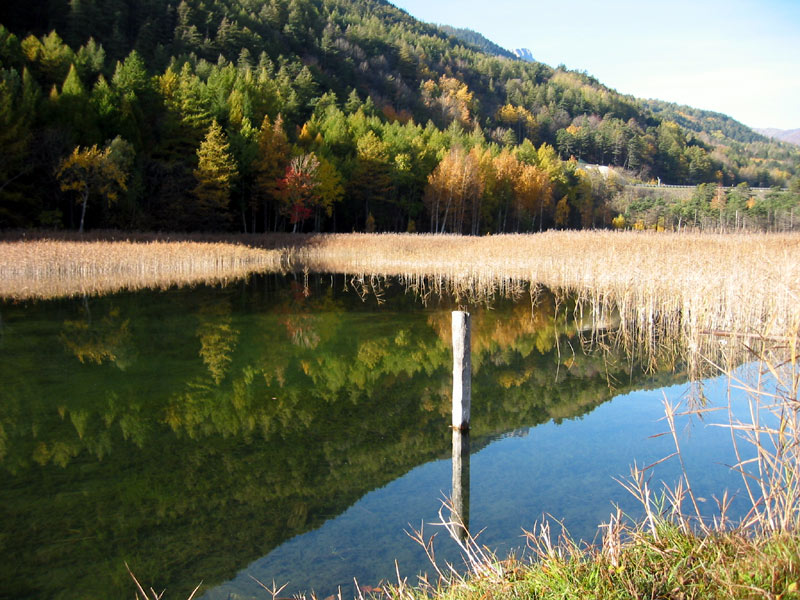Points of Interest
Historical Outline
Lago Borello, known as Stagno di Oulx, originates from a quarry for the
extraction of marly-clayey material used to build the Fréjus Tunnel
(began in 1861). The depression, which formed in the ground after the
withdrawal of great quantities of material, was shortly filled up by
the waters of the springs situated at the foot of Mt. Cotolivier. The
presence of the artificial lake in the mountain area characterized by a
cold climate led to the creation of a small business enterprise for the
production and sale of ice in the last decades of the 19th century. The
icehouse consisted of an igloo-shaped building used as ice warehouse.
The ice was used by the meat processing industries of the middle and
lower Valle Susa to preserve foodstuffs.
The canebrakes and
hygrophilous phytocoenoses immediately colonized the lake shores, which
became in those years a very important tourist resort.
In the second half of the 20th century, the icehouse was abandoned
because of the reduced demand of ice linked to refrigeration technical
innovations and the industrial production of ice. Moreover, when
agricultural practices and grass mowing were abandoned, the lake
surroundings were colonized by herbaceous species linked to the
canebrake dominated by Phragmites australis.
Such change in the floristic composition led to the one side to a
quality-quantity growth in ecological niches used by resident birds and
birds of passage, on the other side to the reduction in the number of
floristic rare species typical of the area, which tend to disappear.
Oulx
Since prehistorical times Oulx has been a meeting and exchange place
for people and cultures, from the Gauls to Caesar's legions, from the
hords of barbarians to the French troops. During the 19th century, Oulx
and its valley have followed the fate of the Kingdom of Sardinia, but
the main event which radically changed local economy and habits was the
building of the Fréjus railway tunnel. With the end of World War II and
the subsequent economic development, the whole valley experienced a
flourishing moment, linked above all to the increase of road and rail
traffic and to the tourist growth favored by the increasing number of
summer and winter tourists in the mountains.
Therefore, it is still
possible to notice in this town the different influences it has
suffered: from monuments to churches, everything recalls the past.
The town is divided in four different areas corresponding to the
development of different sections and are: Vier Damù, that is the upper
town with the old historical center; En Vier, the area of Via Roma;
Abadia, that is the area of San Lorenzo; and Plan, the lower town.
There are many points of attraction:
- Santa Maria Assunta Church
The building rises on the summit of a hillock in the Older Town; among the most important works of art there are the 17th century carved portal, the main altar, and a series of 17th century paintings
- San Michele Arcangelo Church
Romanesque-style church, dating back to the 11th century, is one of the most ancient churches of the Upper Valley. It is situated in Fraz. Beaulard
- San Gregorio Magno Church
The church was consecrated and opened to worship in 1454. The architectural structure has a rectangular plan and Gothic features and its bell tower, typical of Upper Val di Susa and Dauphiné, has four floors and offers a wonderful view. It is in Frazione Savoulx.
- Badia
Complex which is today managed by the Salesian friars, is called Prevostura di Oulx, but it is usually called "Abbadia" or "Badia". In front of the entrance of the church, there is a cross rising in memory or the martyr S.Giusto.
- The Dauphiné Tower
Wrongly called of the Saracens, it rises in the upper part of the older town, not very far from the Parish Church. It represented the sovreignity of the Dauphiné, in a location that had not been enfeoffed.
- Beaume Cave
Dedicated to Saint Mary Magdalene, where the Madonna would have appeared, today the destination of pilgrimages.
- Jardin dla Tour
The main feature is the Outdoor Museum, opened in 2001 by the Municipal administration. This project aims at bringing in the streets and squares artistic evidences of our time, created by some of the most famous representatives of the figurative arts in Piedmont. It is an outdoor permanent exhibition which, developing along the streets, on the walls of public buildings and private houses is dedicated not only to tourists, but above all to the residents of Oulx.
As Mr. Arauld said (president of the Folkloric Group) in an interview "the name of the town is Oulx, not Ulzio. It was Mussolini who italianized all the names, if you read Ulzio, it grips me".








